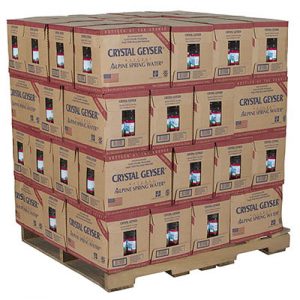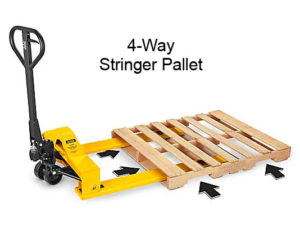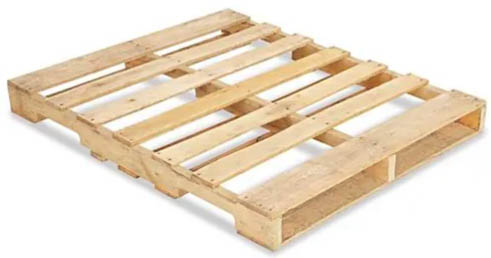Wooden pallets are by far the most common. Wood is used in 90-95% of all pallets produced in the United States. They offer the best balance of strength, stiffness, durability, functionality, and price. The remaining 5-10% of pallets used are made from either plastic, corrugated cardboard, or metal.
 Pallet Strength
Pallet Strength
Pallet strength determines how much load carrying capacity the pallet maintains during shipping and storage of loaded pallets. Most wooden pallets are rated to support one metric ton (2,205 lbs).
With clever structural design, some cardboard pallets can support up to 10,000 lbs. Likewise, plastic pallets come in heavy duty variants that can support upwards of 10,000 lbs.
Pallet Stiffness
Pallet stiffness determines how well the pallet will maintain its shape when loaded. A pallet with insufficient decks, for example, may bulge when loaded. Even if the pallet does not break, the mis-shaped pallet can create pressure on the stacked boxes which can damage the stacked packages and products.
Pallet Durability
Pallet durability determines how well the pallet can hold up to shipping and handling, which typically involves forklifts. When driving forklifts, it is not uncommon for pallets operators to inadvertently strike the pallet with the fork at the entry points, push rather than lift a pallet, or drop a pallet. Durable pallets are better able to withstand the rigors of transporting loaded pallets.
While more costly, plastic pallets are all but completely impervious to climate conditions, while cardboard pallets are extremely susceptible to weather, and cleaning them is all but impossible as water will weaken the paper fibers.
Pallet Functionality
 Pallet functionality determines how easily the pallet can be moved in a warehouse or onto a truck. Four-way stringer pallets allow forklifts to access the pallet from all four sides, which helps for maximum loading on trucks. Two-way custom sized pallets lacking cutout notches on the stringers may limit how the pallets can be placed on a truck, reducing the number of pallets a truck can transport.
Pallet functionality determines how easily the pallet can be moved in a warehouse or onto a truck. Four-way stringer pallets allow forklifts to access the pallet from all four sides, which helps for maximum loading on trucks. Two-way custom sized pallets lacking cutout notches on the stringers may limit how the pallets can be placed on a truck, reducing the number of pallets a truck can transport.
Functionality also can cover resistance to pests. For example, international transport requires wooden pallets be heat treated.
Pallet Weight
Wood pallets are designed to provide maximum strength and durability, using the least amount of wood to prevent pallets from adding excess transportation costs. For example, a 48×40 standard wood pallet weighing 37 lbs. can support a load of 4592 lbs.
Cardboard pallets, as might be expected, are comparatively light, as their strength comes from their corrugated structure rather than material density. However, they lack the strength of wooden pallets. A 42×42 cardboard pallet is typically limited to a racking load of under 1,200 lbs.
Plastic pallets vary in weight depending on design and expected load, starting at around 12 lbs.
Useful Lifespan
Wooden pallets are durable and can easily be used multiple times without damage. In addition, they are easy to repair by adding reinforcement pieces, and can be refurbished by removing and replacing damaged boards. Plastic pallets may last for up to 10 years of use, but if a pallet suffers damage, making repairs is very difficult. Due to the nature of the material, cardboard pallets typically only survive a single use.
Pallet Price
Wooden pallets are the most economical, since they can be reused, and repaired, significantly extending the pallet’s usefulness and cost savings for manufacturers.
Cardboard pallets are relatively inexpensive, but cannot be reused or repaired, and plastic pallets can be quite costly.



